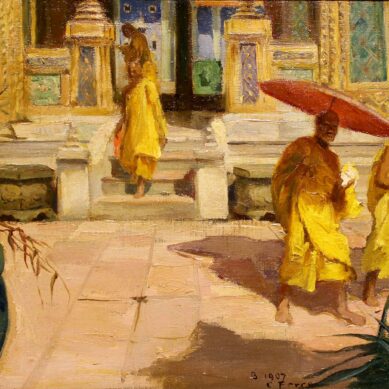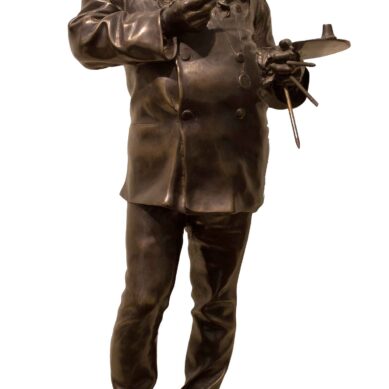You searched
Painter
Cesare Ferro
Are you interested in the sales or the purchase of his artworks?
We buy works of this artist
and of other painters and sculptors from the 16th century to the first half of the 20th century
The Berardi gallery offers a free and without obligation service for evaluation of ancient and modern art . To find your way in the art market, very complex and full of nuances, it is better to rely on a professional consultant who can answer fast and concretely to your needs. The clarity of the answers will resolve effectively the need to estimate or sell an asset.
Contact us immediately without commitment
Answers also in 24 hours:
Cesare Ferro
Cesare Ferro
Cesare Ferro was born in Turin in 1880. He trained at the Albertina Academy following Giacomo Grosso, immediately specializing in portraits, genre scenes, figure paintings and landscape paintings. He made his debut at the Turin Promoter of 1898 with two miniatures on ivory, inaugurating a flourishing exhibition season at this review. In 1899 he created the Cartel – Réclame for the Turin Promoting Society of Fine Arts and the following year he exhibited his first oil portrait there.
In 1903 he presented himself instead with Ballo in Montagna, a painting characterized by an intimate moon effect, testimony of his frequent stays in his beloved Usseglio, a mountain town that gave him his main inspiration, as is also clearly visible from the Alba opera by Benot. At the beginning of the twentieth century he participated, together with Felice Carena, in the symbolist climate that was spreading in Piedmont, enriching the portraits of him and his interior scenes with a previously absent mystical tension.
Pastel or oil portraits appear at the exhibitions, full of an intimate and personal symbolism, which emerges for example from the two works presented in Florence in 1902, the Nudo oil studio and the Pastel Girl. His most significant painting of this first phase, L’attesa, appeared for the first time at the Venice Biennale in 1903, and then reappeared several times and in different versions in subsequent reviews. From the most anguished and realist interpretation to the most symbolist and allegorical one, that of waiting becomes one of Ferro’s favorite themes. In 1904 one of his Portrait of a Lady was awarded a gold medal at the Parisian Salon, while at the 1905 Biennale he sent a Portrait.
In the meantime, precisely in 1904, Cesare Ferro received an assignment that led to the first real evolution of his themes and his poetics: the king of Siam Rama V invited him to court until 1907 and then again between 1923 and 1924 to help decorate the Royal Palace in Bangkok. In these stays Cesare Ferro, while he is taking care of the decoration of the Palace, gives life to a fresh and lively production dedicated to Thailand.
Great observer and curious traveler, he enters the Siamese culture, capturing its colors, sounds, smells, customs. He interprets bright interior paintings characterized by a clear and varied palette, aimed at interpreting the wonder of the oriental world, with its customs, its moments of everyday life, its majestic buildings and objects.
Studies, drawings, oils and pastels dedicated to dancers, soldiers, courtiers, people of the people appear, inserted in sumptuous interiors, in colorful parties, in the gardens of Bangkok, in its canals. Examples are paintings such as the Atrium of the Royal Temple Wat Phra Keo in Bangkok, Interior in Bangkok, Siamese Dancers, a series of masterpieces with dazzling chromatic richness, far from his Turin production. About one hundred studies from his first stay in Siam appear in the Siamese Pavilion of the 1911 Turin Exposition.
Returning to his homeland, before his second trip to Thailand, Ferro dedicated himself to the production of portraits and figure and interior paintings, combining his pictorial activity with that of a teacher at the Albertina Academy. He participates in the First World War, without stopping to draw and carry out studies of the landscapes of Valcamonica, where he is a lieutenant.
In 1920 she married and became his father: his studies and paintings acquired a further intimacy and personal family vision, so much so that in Milan, in 1921 he presented Mother, while at the 1922 Venice Biennale he sent Maternity and Portrait of his wife. 1923 is the year of his second trip to Siam, to finish the royal decorations: even more brilliant designs and oils appear after this renewed experience. Among them, Siamese Dancer, one of his most successful paintings for freshness and chromatic balance.
Returning to Turin in 1924 he continues to paint, but combines easel painting with fresco decoration in some Ligurian and Piedmontese churches. In recent years his production is full of portraits and sensual nudes, but also of intimate family themes, such as First steps or Mother and child, presented at the Turin Quadriennale in 1927. He dies in Turin in 1934.






